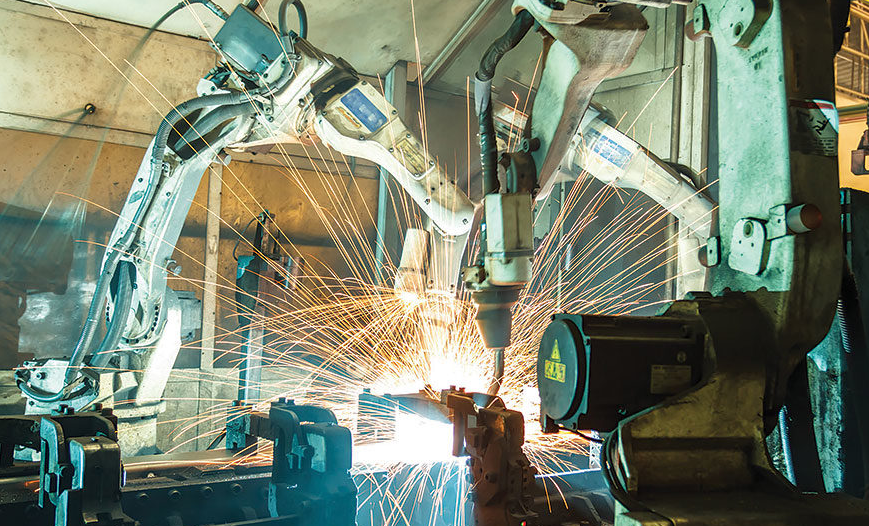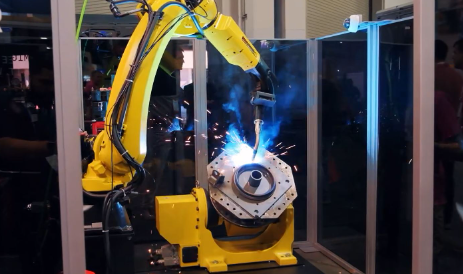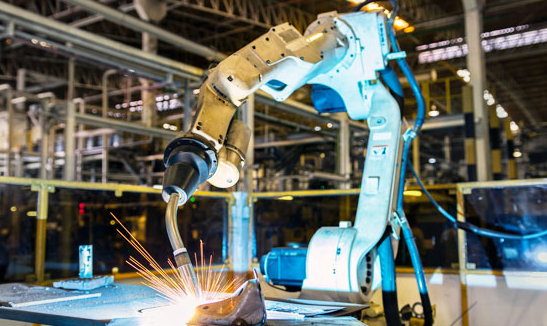The best type of welding for robotics largely depends on the specific application, but Gas Metal Arc Welding (GMAW) or MIG is widely favored for its versatility and efficiency.
Introduction
The realm of welding has undergone a remarkable transformation over the past few decades, particularly with the advent and integration of robotics. This journey from manual welding practices to robot-assisted ones has not only increased efficiency but also brought forth precision and consistency that was previously hard to achieve.

Background of robotic welding
Robotic welding was conceived as an answer to the industrial need for faster, more consistent, and safer welding processes. Introduced in the 1980s, the first robotic welding systems were somewhat rudimentary, often limited in flexibility and range. However, they set the foundation for what was to come.
Today’s robotic welding systems combine advanced computer programming with precise mechanics, allowing for sophisticated movements and a level of consistency that human welders find challenging to match. Some notable advantages include:
- Speed: Modern robotic welders can complete tasks at an impressive speed of up to 120 inches per minute, making them an invaluable asset in high-volume production scenarios.
- Quality: With an error rate of less than 0.01%, robotic welders offer unparalleled quality, especially in repetitive tasks where consistency is crucial.
- Cost-Efficiency: Despite the initial high setup cost (often upwards of $100,000 for advanced systems), robotic welders can lead to long-term savings due to reduced wastage of materials and increased production speed.
Evolution of welding techniques
The evolution of welding techniques is a testament to human ingenuity and the quest for perfection. Traditional welding, which relies on heat and pressure, has been around for millennia. Ancient civilizations, like the Egyptians, used rudimentary forms of welding to join metals.
Fast forward to the 19th century, and the introduction of electric arc welding marked a significant milestone. This technique utilized an electric arc to produce the required heat, resulting in stronger welds and faster processes.
In the mid-20th century, techniques like Gas Tungsten Arc Welding (GTAW) or TIG and Gas Metal Arc Welding (GMAW) or MIG were introduced, offering more control over the welding process and better weld quality.
However, the real game-changer arrived with the marriage of welding and robotics. The first robotic welding systems, while basic, paved the way for today’s advanced systems. These robots, equipped with sensors and advanced programming, can detect inconsistencies in materials and adjust parameters in real-time, ensuring optimal weld quality and efficiency.
In terms of power, modern robotic welders operate at varying power levels, often between 100 to 600 watts, depending on the specific application and material in use. This ability to adjust power ensures longevity and efficiency, with some robots boasting a lifespan of 10-15 years, making them a worthy investment for industries.
Types of Welding Techniques
The world of welding is intricate and varied, with each technique offering its own unique advantages and applications. While traditional methods still hold value, the advancements in technology have ushered in a range of innovative welding techniques that cater to diverse industrial requirements.
Gas Metal Arc Welding (GMAW) or MIG
GMAW or MIG welding is one of the most popular welding methods, primarily because of its versatility. It utilizes a consumable wire electrode that’s continuously fed through a welding gun. This process works with a variety of metals, including stainless steel, aluminum, and carbon steel.
- Speed: MIG welding can achieve speeds of up to 50 inches per minute.
- Cost: The average cost for MIG welding equipment ranges from $500 to $2000, making it an affordable option for many.
- Advantages: It’s known for its ease of use and high-speed performance.
Gas Tungsten Arc Welding (GTAW) or TIG
TIG welding stands out due to its clean and precise welds. It employs a non-consumable tungsten electrode and is commonly used for thin sections of stainless steel, non-ferrous metals like aluminum, magnesium, and copper alloys.
- Precision: TIG offers a high level of precision, making it suitable for intricate jobs.
- Cost: TIG welding setups typically range from $1000 to $5000.
- Quality: It’s acclaimed for producing high-quality and aesthetically pleasing welds.
Spot Welding
Spot welding is a resistance welding method where metal surfaces are joined by heat resulting from resistance to electric current flow. It’s primarily used in the automotive industry.
- Speed: Each weld can be completed in milliseconds, allowing for rapid production.
- Cost: Industrial-grade spot welding machines can cost anywhere from $2000 to $10,000.
- Application: Primarily used for assembling sheet metals.
Laser Welding
Laser welding uses a focused laser beam to melt and join metals. It’s known for its high-speed, precision, and capability to weld in difficult-to-reach areas.
- Precision: Capable of producing welds as small as 0.5mm in diameter.
- Cost: Laser welding systems can range from $20,000 to over $500,000 for advanced setups.
- Advantages: Minimal heat distortion and high-speed operation.
Electron Beam Welding
Electron beam welding is a fusion welding process that employs a focused beam of high-velocity electrons to join materials. It’s often done in vacuum chambers.
- Quality: Known for producing high-quality, defect-free welds.
- Cost: Systems typically range from $100,000 to $1 million, given the need for specialized equipment like vacuum chambers.
- Application: Ideal for joining high-melting-point materials.
Resistance Welding
This technique uses the application of electric current and mechanical pressure to create welds between metal surfaces.
- Efficiency: Can produce multiple welds simultaneously, increasing production rates.
- Cost: Equipment costs vary widely, ranging from $5,000 to $50,000.
- Advantages: Efficient for large-scale production.
Arc Welding
Arc welding is one of the oldest and most versatile welding processes. It uses an electric arc between an electrode and the workpiece to melt the metals at the welding point.
- Flexibility: Suitable for both indoor and outdoor environments.
- Cost: Basic arc welding setups can start as low as $100, with professional rigs ranging up to $2000.
- Application: Widely used in construction, fabrication, and repair work due to its flexibility and cost-effectiveness.

Factors Determining the Best Type for Robotics
Choosing the right welding technique for robotic applications goes beyond just selecting the most advanced or latest technology. Various factors play a crucial role in this decision-making process, ensuring that the chosen method aligns well with the specific requirements of the task at hand. Let’s delve deeper into these determinants.
Material compatibility
For instance, TIG welding is especially effective for non-ferrous metals like aluminum, magnesium, and some copper alloys. On the other hand, MIG welding is versatile and suitable for a range of materials, including stainless steel and carbon steel.
- Importance: Matching the welding technique to the material ensures strong and durable welds.
- Example: Laser welding is preferred for metals like titanium or nickel alloy due to its precision and minimal heat distortion.
Precision and quality requirements
Certain industries or products demand extremely precise welds. For example, aerospace components or medical devices need high precision to ensure safety and functionality.
- Standard: TIG and laser welding are renowned for their precision, often achieving tolerances as tight as ±0.01 mm.
- Quality: Electron beam welding, executed in vacuum chambers, is known for producing high-quality, defect-free welds essential for critical applications.
Speed and efficiency
Production timelines and volumes greatly influence the choice of welding technique. High-volume manufacturing setups often prioritize speed.
- Comparison: While spot welding can complete a weld in milliseconds, TIG welding, known for its quality, is relatively slower, often achieving speeds of 5-20 inches per minute.
- Optimization: Arc welding is commonly used in construction due to its flexibility and decent speed, making it efficient for large projects.
Cost implications
Budget constraints often play a pivotal role in determining the welding technique. While some processes may offer superior results, their cost might be prohibitive for certain industries or projects.
- Investment: Advanced laser welding setups can range from $20,000 to over $500,000, whereas basic arc welding rigs can start as low as $100.
- Operational Costs: Techniques like electron beam welding, while providing exceptional quality, come with high operational costs due to the need for vacuum chambers and specialized maintenance.

Safety considerations
Safety is paramount in any industrial setup. Certain welding techniques, due to their nature, might pose more safety risks than others.
- Consideration: Laser and electron beam welding, due to their high-energy beams, require stringent safety measures, including protective eyewear and isolated operation zones to prevent accidental exposure.
- Benefit: Robotic welding, by design, minimizes human interaction with the actual welding process, inherently enhancing safety. However, proper safety protocols, especially with high-intensity techniques, remain essential.
Advantages of Robotic Welding
The integration of robotics into the welding industry has ushered in a new era of efficiency and precision. By harnessing the power of advanced robotics, businesses can unlock numerous advantages that not only enhance the quality of the output but also optimize the production process. Let’s explore the key advantages of robotic welding in detail.
Increased production speed
- Comparison: While manual welding might achieve speeds of 10-20 inches per minute, depending on the process and expertise of the welder, robotic welding can consistently hit speeds of up to 50 inches per minute or even higher.
- Efficiency: With the ability to operate 24/7, robotic welding can dramatically increase the number of units produced in a given time frame.
Enhanced accuracy and repeatability
Precision is paramount in welding, especially in industries that demand high tolerances. Robotics offer unparalleled consistency in this regard.
- Tolerance: Robotic systems can consistently achieve tolerances as tight as ±0.01 mm, which is often challenging for manual welding.
- Repeatability: Robots follow programmed paths with extreme precision, ensuring that each weld is virtually identical to the last, eliminating the variability that can come with human welders.
Reduction in labor costs
While the initial investment in robotic welding might be substantial, the long-term savings in labor costs can be significant.
- Operational Costs: A single robotic welding system, which can operate continuously without breaks, might replace the need for multiple welders across different shifts, leading to savings in salaries, benefits, and training costs.
- ROI: Given the efficiency and speed, businesses often find that the return on investment (ROI) for robotic welding equipment can be realized within a few years, if not months, depending on the scale of operations.

Improved safety
Welding, by its nature, involves certain risks, from exposure to intense light and heat to the dangers of molten metal. Robotic welding can drastically reduce these risks.
- Human Interaction: By minimizing human interaction with the actual welding process, the chances of accidents or injuries related to direct exposure are significantly reduced.
- Environment: Robotic welding systems often come equipped with advanced ventilation and filtration systems, ensuring a cleaner and safer environment for workers in proximity.
Challenges and Limitations
While robotic welding undoubtedly brings a myriad of advantages to the table, it’s crucial to understand that this technology isn’t without its challenges and limitations. Recognizing these obstacles allows businesses to make informed decisions and prepare for any complications that might arise.
Initial setup and investment costs
Setting up a robotic welding system requires not only the cost of the robot itself but also the peripherals and infrastructure that support it.
- Cost Analysis: A basic robotic welding system might start at $50,000, while advanced systems with additional features can soar beyond $200,000. Additionally, the costs of training personnel, retrofitting existing infrastructure, and buying compatible software can further increase initial expenses.
- Long-term View: Although the return on investment (ROI) for robotic welding can be substantial in the long run, businesses need to ensure they have the financial capability to manage the upfront costs.
Maintenance of robotic systems
Like any machinery, robotic welding systems require regular maintenance to operate efficiently and reliably.
- Maintenance Costs: Routine servicing, part replacements, and software updates can accumulate an annual maintenance cost ranging from $2,000 to $10,000, depending on the complexity of the system.
- Downtime: Unexpected breakdowns or system failures can halt production. While manual welding setups can sometimes bypass a malfunctioning unit, a robotic system’s malfunction can bring the entire production line to a standstill, leading to potential revenue loss.
Limitations in adaptability to complex geometries
Robotic welding systems excel in repetitive, standardized tasks but can face challenges when dealing with intricate geometries or constantly changing designs.
- Flexibility: While advancements in robotics have improved adaptability, certain complex or intricate welds might still require human finesse. For example, welding a detailed artwork or custom, one-off pieces can be challenging for robotic systems to adapt to.
- Reprogramming: For businesses that frequently change their product designs or have limited production runs for each design, the time and cost of reprogramming the robot for each new task can become significant.




